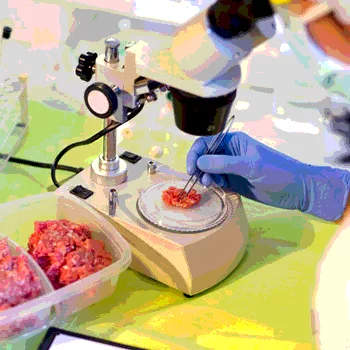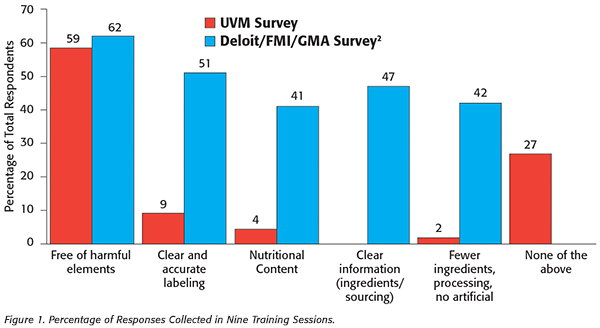Perception of Food Safety by Food Manufacturers and Food Safety Professionals

Most food safety regulations have defined the hazards associated with the consumption of food and pose a danger to public health. Food safety regulations in most countries, including the standards by the Codex Alimentarius, target manufacturing, processing, packing, or holding practices to minimize, control, or prevent the appearance of known hazards. In the U.S., for instance, hazard means “any biological, chemical (including radiological), or physical agent that has the potential to cause illness or injury”.[1] As we have acquired more knowledge on the type of hazards found in food, we have also started to categorize hazards based on “significance” in addition to the traditional classifications of biological, chemical, and physical. Thus, food safety systems target the most significant hazards. In the U.S., significant hazards that require preventive controls have a complex definition: a known or reasonably foreseeable hazard for which a person knowledgeable about the safe manufacturing, processing, packing, or holding of food would, based on the outcome of a hazard analysis (which includes an assessment of the severity of the illness or injury if the hazard were to occur and the probability that the hazard will occur in the absence of preventive controls), establish one or more preventive controls to significantly minimize or prevent the hazard in a food and components to manage those controls (such as monitoring, corrections or corrective actions, verification, and records) as appropriate to the food, the facility, and the nature of the preventive control and its role in the facility’s food safety system.
Although food hazards are concrete and well-defined, the term “food safety” has different meanings for different individuals within or across different cultures. The interpretation of safety has been evolving to the point in which safety, health. and wellness can all be interrelated in people’s minds.[2]
In this article, I report the results of a survey that was conducted among food safety professionals (food manufacturers, food inspectors, and other food industry professional working on food safety) who participated of food safety training or attended lectures provided by the University of Vermont Extension. The study was designed as a one-question survey where participants were asked to respond to the question “which answer is the best definition of safety?” This question was taken from a previous national survey in the USA where individuals from the public were asked a similar question.[2] The possible answers included:
• Free of harmful elements
• Clear and accurate labelling
• Clear information (ingredients/sourcing)
• Fewer ingredients, processing and no artificial
• Nutritional content
• None of the above
The possible answers were also the same as the ones presented in the national survey, but with the addition of the “none of the above” and with the difference that only one answer was allowed, versus the previous survey where respondents could select more than one answer.[2]
All participants were shown a slide, which was read in all presentations, stating that their participation in the survey was voluntary. This question was presented in nine lectures/training classes and a polling system[3]) was used to collected the answers by the participants who chose to respond.
 With this survey, I collected 123 responses. The results of all the responses and compared to the survey by Ringquist et al.[2] can be seen in Figure 1. The results showed that most individuals (59%) chose the option “free of harmful elements,” similarly to the 62 percent of respondents that selected the same answer choice in the survey by Ringquist et al.[2] A comparison of these two percentages with the chi-square test for given probabilities in R[4] showed that these values were not statistically different (P = 0.78; χ2 = 0.074).
With this survey, I collected 123 responses. The results of all the responses and compared to the survey by Ringquist et al.[2] can be seen in Figure 1. The results showed that most individuals (59%) chose the option “free of harmful elements,” similarly to the 62 percent of respondents that selected the same answer choice in the survey by Ringquist et al.[2] A comparison of these two percentages with the chi-square test for given probabilities in R[4] showed that these values were not statistically different (P = 0.78; χ2 = 0.074).
The response “free of harmful element” is quite appealing as a definition of “food safety,” but does not account for the way food is manufactured around the world, when guaranteeing that the food is “free” of hazards is not always the case. In addition, the consumption of hazards does not always result in foodborne illnesses, and the concept of food free of all hazards is not consistent with trends for more unprocessed, raw food products. In the case of minimally processed or raw foods, food manufacturers are left with very few known options to consistently control or prevent hazards. As we learn more about food hazards and their control, we have evolved from the idea of “eliminating” hazards from foods, a term that was part of the definition of critical control point in Hazard Analysis and Critical Control Points regulations,[5,6] to the idea of controls that focus on significantly minimizing or preventing foodborne hazards.[7] The understanding that foods may contain hazards but the impact of those hazards in public health are minimal is extremely important for risk communication in food safety.
At the end of the poll, all participants were asked to discuss the different options and “none of the above,” which was selected by 27 percent of participants, always appeared as the most appropriate response based on the lack of a consistent definition of food safety and the fact that verifying if a lot of food is free of harmful elements is seldom done. It is important to highlight that the perceived response of “none of the above” was the most logical response for more than half of the participants. Yet, the most appropriate response may not always be the ones we identify as most “logical.”
Our previous study showed that only 56 percent of food manufacturers can select the most appropriate definition of hazards.[8] Therefore, terms that are more complex, such as risk and food safety, are more likely to be defined based on individuals’ perception and not based on any scientific definition. The perception that we already have of certain foods may also play an important role on how we interpret the safety of those foods, and consequently the actual scientific knowledge about the safety of certain foods is not the main driver in our understanding of safety.[9]
Although our survey was in many aspects different to the one by Ringquist et al.[2] (sample size, targeted population, etc.), the similarity in the most commonly selected answer implies that food manufacturers responded like the public when defining food safety. This assumption has several implications related to food safety and risk communication between food manufacturers and the public, where the concept of safety is already driven by perception and not our most current scientific understandings. Risk communication becomes more challenging between the public, food manufacturers, and public health officials when there is a lack of shared definitions of basic terms, the media amplify the request for food “free” of hazards, and there is an optimistic bias by consumers toward certain food categories.[10]
Challenges still remain on how to teach or explain the most important hazards to food manufacturers to ensure risk-based food safety systems produce the expected impact in controlling and/or preventing significant hazards. The training material should include methods for self-assessment of perception and biases. The benefits of this type of training include improved public health by having more informed food manufacturers and a public with increased trust on public health institutions and the food industry.
No federal grants were used for this study and the author declares no competing interest.
Omar A. Oyarzabal, Ph.D., is an associate professor of food safety at the University of Vermont.
References
1. www.gpo.gov/fdsys/pkg/FR-2015-09-17/html/2015-21920.htm.
2. www2.deloitte.com/content/dam/Deloitte/us/Documents/consumer-business/us-fmi-gma-report.pdf.
3. www.polleverywhere.com.
4. www.R-project.org.
5. Food Safety and Inspection Services. U. S. Department of Agriculture. 1996. “Pathogen Reduction; Hazard Analysis and Critical Control Point (HACCP) Systems; Final Rule.” Federal Register 61(144):38805–38989.
6. Food and Drug Administration. Department of Health and Human Services. 2001. “Hazard Analysis and Critical Control Point (HACCP); Procedures for the Safe and Sanitary Processing and Importing of Juice; Final Rule.” Federal Register 66(13):6137–6202.
7. www.fda.gov/newsevents/publichealthfocus/ucm239907.htm.
8. www.heliyon.com/article/e00297.
9. Hilverda, F and M Kuttschreuter. 2018. “Online Information Sharing about Risks: The Case of Organic Food.” Risk Anal 38(9):1904–1920.
10. Yu H, JA Neal, and SA Sirsat. 2018. “Consumers’ Food Safety Risk Perceptions and Willingness to Pay for Fresh-Cut Produce with Lower Risk of Foodborne Illness.” Food Control 86(Supplement C):83–89.
Looking for quick answers on food safety topics?
Try Ask FSM, our new smart AI search tool.
Ask FSM →







